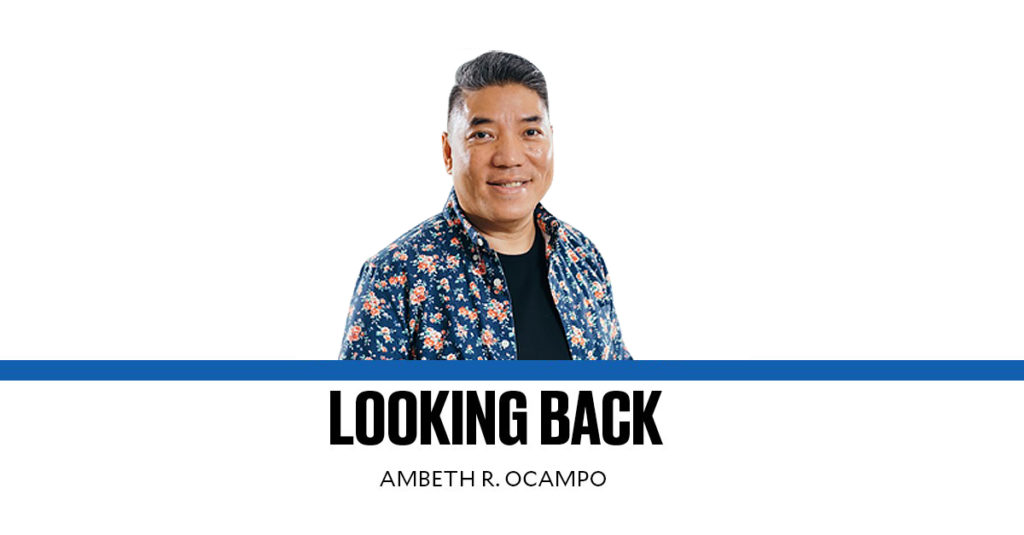The phone rang in my uncle’s living room one day, and we heard the househelp answer politely, “Good morning po.”
The person on the other end wanted my uncle on the line, “maari po ba makausap si Mr. Ocampo.”
“Sino pong Mr. Ocampo ang gusto n’yo makausap,” the help inquired as a reply, “ang babae o ang lalaki?”
In a similar way, one had to be clear when one asked to speak to former education secretary and University of the Philippines (UP) president Onofre D. “O.D.” Corpuz on the phone because there were two “Dr. Corpuz” in residence: O.D. and his wife Dr. Aurora Corpuz, professor and former Dean of the UP College of Home Economics.
I remember O.D. each time I look at the 55-volume compilation of Philippine documents by Emma Helen Blair and James Alexander Robertson on my reference shelf, because he is the only person I know who has read each and every volume from cover to cover, not once but twice. If that isn’t impressive enough O.D. could quote whole sections verbatim drawing from his near photographic memory. Corpuz came from a generation when people made their eyes and fingers do the walking on the pages of physical books. Today’s generation scroll and read text on smartphones, tablets, and computer screens. Information can be had with one click on a mouse or trackpad.
Following Corpuz’s example, I arranged my library to have reference books literally an arm’s length from the shelves to my work desk. English, Spanish, French, German, Latin, and Filipino dictionaries occupied a shelf together with a thick one-volume Columbia desk encyclopedia, and other reference works: Zoilo Galang’s 20-volume “Encyclopedia of the Philippines,” the 10-volume “Filipino Heritage,” Gregorio Zaide’s 12-volume “Documentary sources of Philippine history,” etc. Google made a lot of these standard references obsolete.
Some years ago, I decided to recover shelf space by chucking out dictionaries of foreign languages except for the compact Oxford English Dictionary, that provides a history of the usage and evolution of words. Foreign encyclopedias were also discarded leaving only the Filipiniana on my shelves. Dictionaries and Spanish-era “vocabularies” of Philippine languages have always provided both education and entertainment. From the short list of Philippine words compiled by Antonio Pigafetta, the chronicler of the Magellan expedition in 1521 to Vito C. Santos aka “Vicassan’s Pilipino-English” and “English-Pilipino” dictionaries updated in the 21st century I have drawn hours and hours of fun.
I do not own a first edition copy of Pedro de San Buenaventura’s 707-page “Vocabulario de la lengua tagala,” published in Pila, Laguna, in 1613 by Nicolas de la Cruz Bagay and Domingo Loag, just a facsimile copy and a transcription in a digital file. For many years, till a facsimile was published in Spain in the 1980s, the only known copy was in the British Library (a facsimile was presented to the National Library of the Philippines on the occasion of Rizal’s birth centenary in 1961), surely there were other early vocabularios of Tagalog and other Philippine languages compiled by the religious but these remain unpublished and in manuscript form.
In 2000, another rare Tagalog vocabulario was reprinted by a now defunct group in the Ateneo known as Pulong Sources for Philippine Studies. The “Vocabulario tagalo” attributed to the Franciscan Francisco de San Antonio is the merging of two manuscript copies, one in the University of Santo Tomas archives and the other in the Bibliotheque Nationale de France in Paris, the former referred to as the Manila Codex, the other the Paris Codex.
One can only hope that more of these rare vocabularios come to light and be available online not just to show how Spanish missionaries created tools for the evangelization of the Philippines, but also to see how Filipinos learned Spanish and made a foreign culture their own.
Dictionaries are bridges that connect people separated by language and culture. It frustrates me to think that some misguided people privilege recent publications over old “obsolete” books. One does not normally turn to dictionaries for history, but these word lists can be read as primary sources that open windows into life in the late 16th and early 17th century Philippines.
—————-
Comments are welcome at aocampo@ateneo.edu
